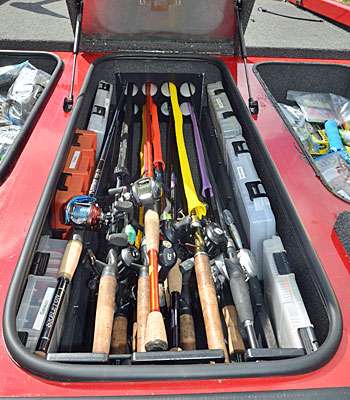
No, we’re not calling you fat.
But we might be calling your boat a little chunky, especially if you know in your heart that you’re not getting everything possible out of it performance-wise. The first step in regaining lost miles per hour and hole shot is taking an honest-to-goodness inventory of all the “stuff” in your boat.
Things like PFDs, a spare prop, flare gun, tools and all that goodness are no-brainers. You’ve got to have them. Also put other necessities into this category. These are things like your depthfinders, jackplate and other items not easily removed.
Now, the fun stuff like tackle, rods and baits is where you need to scrutinize your load the most. Do you really need seven different colors of Brush Hogs or Speed Worms? Whether you like to hear it or not, no, you likely don’t. You also likely don’t need 115 Rat-L-Traps, especially since 90 of them are chrome-and-blue. Terminal tackle is the worst, especially if you’re on a hot flipping bite and toting a box full of 1-ounce-plus sinkers. Relegate hooks, sinkers and soft plastics to the aft storage areas of your boat. Many Elite Series pros do it, especially those with the faster rigs. Crankbaits and spinnerbaits are fine to keep up front but try to keep them as close to centerline as possible, that way your load isn’t “pushing” down on the periphery, which will put more of the hull in the water, causing more drag. Less drag equals more speed. For you military guys, the old saying “high speed, low drag” applies.
Though you might lose a few pounds by taking out unnecessary tackle, where you carry the weight in your boat is perhaps more important than what you’re carrying. Aluminum boats are more susceptible to weight issues than are fiberglass rigs because their hulls are lighter to start with.
Shifting 50 pounds of weight to the back will net you a better top end and handling than if you’re boat is front-heavy. In this feature, Elite Series pro Mark Menendez says that carrying your heavier items in the back of the boat makes for an all-around better ride. Stephen Browning, on the other hand, has a plan on where his gear goes based on the kind of water he’ll be fishing or the conditions he might encounter.
“Most of the time, I put all of my heavier stuff like jigs and weights in the back of the boat. It gives the front end of the boat a little more lift if you’re trying to hit top end,” he says. “Conversely, if I’m fishing areas where I’ll need to be in some really shallow water, I’ll put all of that up front so I can get on plane faster. Again, on a long run where top speed is important, keep the heavier gear in the back.”
Once you’ve got your boat on the marine version of Jenny Craig, it’s time to start looking at things that can make more of a real-world seat-of-the-pants difference in how your tin rocket performs (without voiding your outboard’s warranty): props and jackplates.
Take a look at this photo gallery for some ideas on how to better balance your boat. See Part 2: Add a jackplate and Part 3: Select the right prop.




